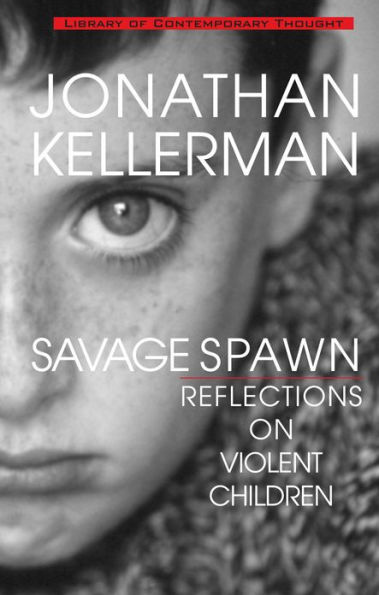This thought-provoking and timely book from a #1 New York Times bestselling novelist and noted child psychologist reveals the factors that often lead to explosive and shocking juvenile violence.
“Ethically and morally, kids are works in progress. Throw in psychopathy and you’ve got a soul that will never be complete.”
In this powerful, disturbing book, bestselling author and noted child psychologist Jonathan Kellerman shines a penetrating light on antisocial youth—kids who kill without remorse—asserting that “psychopathic tendencies begin very early in life, as young as three, and they endure.” Criticizing our quick impulse to blame violent movies or a “morally bankrupt” society, Kellerman convinces us that it is the kids themselves who need to be examined. Carefully.
How do children become cold-blooded killers? Kellerman warns that today’s aggressive bully is tomorrow’s Mafia don, cult leader, or genocidal dictator. Violently psychopathic youths possess an overriding need for power, control, and stimulation, and all display a complete lack of regard for the humanity of others. He examines the origins of psychopathy and the ever-shifting debate between nurture and nature, offering some controversial solutions to dealing with homicidal tendencies in children.
As timely as today’s headlines, more gripping than fiction, Savage Spawn is a provocative look at the links between society and biology, children and violence. Kellerman’s sobering message will remain with you long after the last page is turned.
BONUS: This edition includes an excerpt from Jonathan Kellerman’s Guilt.
1003224802
“Ethically and morally, kids are works in progress. Throw in psychopathy and you’ve got a soul that will never be complete.”
In this powerful, disturbing book, bestselling author and noted child psychologist Jonathan Kellerman shines a penetrating light on antisocial youth—kids who kill without remorse—asserting that “psychopathic tendencies begin very early in life, as young as three, and they endure.” Criticizing our quick impulse to blame violent movies or a “morally bankrupt” society, Kellerman convinces us that it is the kids themselves who need to be examined. Carefully.
How do children become cold-blooded killers? Kellerman warns that today’s aggressive bully is tomorrow’s Mafia don, cult leader, or genocidal dictator. Violently psychopathic youths possess an overriding need for power, control, and stimulation, and all display a complete lack of regard for the humanity of others. He examines the origins of psychopathy and the ever-shifting debate between nurture and nature, offering some controversial solutions to dealing with homicidal tendencies in children.
As timely as today’s headlines, more gripping than fiction, Savage Spawn is a provocative look at the links between society and biology, children and violence. Kellerman’s sobering message will remain with you long after the last page is turned.
BONUS: This edition includes an excerpt from Jonathan Kellerman’s Guilt.
Savage Spawn: Reflections on Violent Children
This thought-provoking and timely book from a #1 New York Times bestselling novelist and noted child psychologist reveals the factors that often lead to explosive and shocking juvenile violence.
“Ethically and morally, kids are works in progress. Throw in psychopathy and you’ve got a soul that will never be complete.”
In this powerful, disturbing book, bestselling author and noted child psychologist Jonathan Kellerman shines a penetrating light on antisocial youth—kids who kill without remorse—asserting that “psychopathic tendencies begin very early in life, as young as three, and they endure.” Criticizing our quick impulse to blame violent movies or a “morally bankrupt” society, Kellerman convinces us that it is the kids themselves who need to be examined. Carefully.
How do children become cold-blooded killers? Kellerman warns that today’s aggressive bully is tomorrow’s Mafia don, cult leader, or genocidal dictator. Violently psychopathic youths possess an overriding need for power, control, and stimulation, and all display a complete lack of regard for the humanity of others. He examines the origins of psychopathy and the ever-shifting debate between nurture and nature, offering some controversial solutions to dealing with homicidal tendencies in children.
As timely as today’s headlines, more gripping than fiction, Savage Spawn is a provocative look at the links between society and biology, children and violence. Kellerman’s sobering message will remain with you long after the last page is turned.
BONUS: This edition includes an excerpt from Jonathan Kellerman’s Guilt.
“Ethically and morally, kids are works in progress. Throw in psychopathy and you’ve got a soul that will never be complete.”
In this powerful, disturbing book, bestselling author and noted child psychologist Jonathan Kellerman shines a penetrating light on antisocial youth—kids who kill without remorse—asserting that “psychopathic tendencies begin very early in life, as young as three, and they endure.” Criticizing our quick impulse to blame violent movies or a “morally bankrupt” society, Kellerman convinces us that it is the kids themselves who need to be examined. Carefully.
How do children become cold-blooded killers? Kellerman warns that today’s aggressive bully is tomorrow’s Mafia don, cult leader, or genocidal dictator. Violently psychopathic youths possess an overriding need for power, control, and stimulation, and all display a complete lack of regard for the humanity of others. He examines the origins of psychopathy and the ever-shifting debate between nurture and nature, offering some controversial solutions to dealing with homicidal tendencies in children.
As timely as today’s headlines, more gripping than fiction, Savage Spawn is a provocative look at the links between society and biology, children and violence. Kellerman’s sobering message will remain with you long after the last page is turned.
BONUS: This edition includes an excerpt from Jonathan Kellerman’s Guilt.
12.99
In Stock
5
1

Savage Spawn: Reflections on Violent Children
144
Savage Spawn: Reflections on Violent Children
144Related collections and offers
12.99
In Stock

Product Details
| ISBN-13: | 9780345463661 |
|---|---|
| Publisher: | Random House Publishing Group |
| Publication date: | 04/01/2003 |
| Sold by: | Random House |
| Format: | eBook |
| Pages: | 144 |
| Sales rank: | 734,334 |
| File size: | 274 KB |
About the Author
From the B&N Reads Blog
